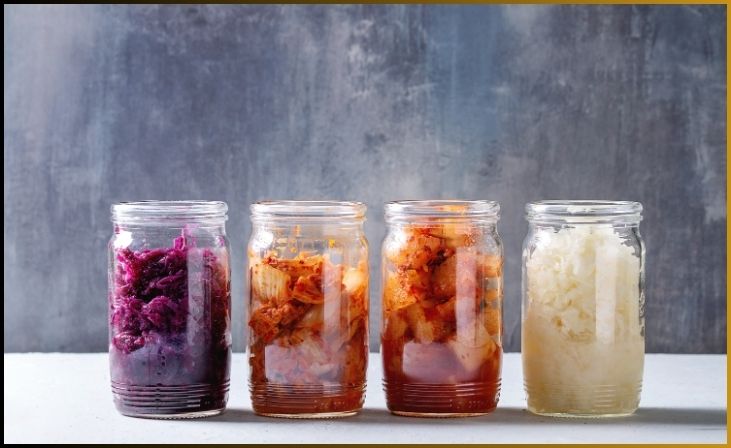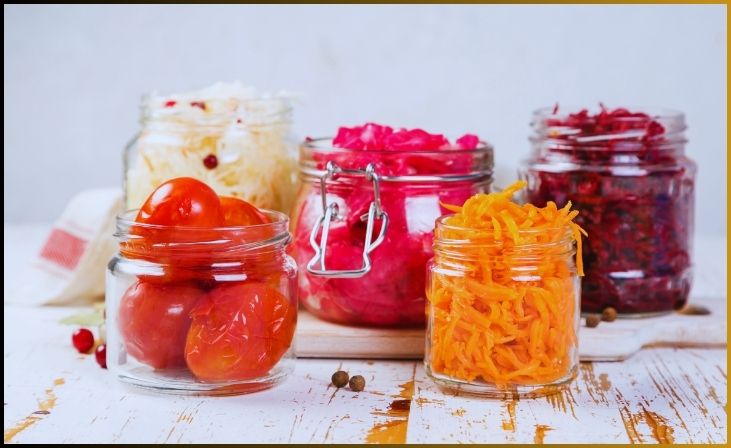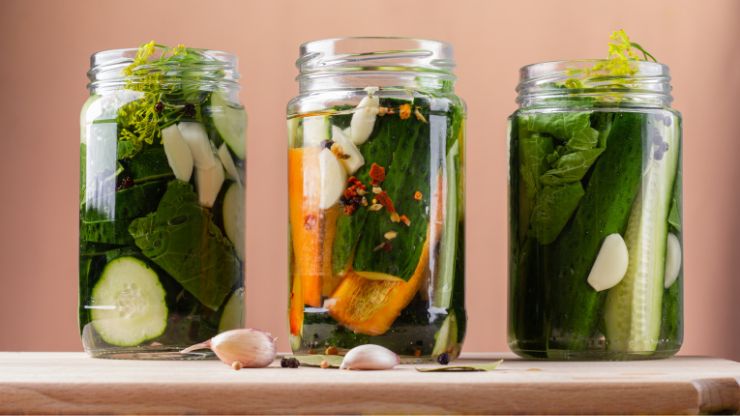you must gain your knowledge about Step-by-Step Guide to Making Fermented Foods at Home. Fermented foods have been a part of human diets for centuries, offering a unique blend of flavors, textures, and health benefits. Making fermented foods at home is not only a rewarding culinary adventure but also a way to promote gut health and enhance your immune system. In this step-by-step guide, we’ll walk you through the process of creating delicious and nutritious fermented foods right in your kitchen.
Fermentation is a natural process that involves the breakdown of carbohydrates by microorganisms like bacteria and yeast. This metabolic process not only preserves the food but also enhances its flavor and nutritional value.
Table of Contents
ToggleBenefits of Fermented Foods

Delving into the world of fermented foods offers more than just flavorful additions to your meals; it introduces a cohort of beneficial bacteria, known as probiotics, to your gut. These microscopic allies play a pivotal role in fostering a healthy gut microbiome, contributing to the intricate balance of digestive processes. Beyond digestion, probiotics enhance nutrient absorption, ensuring your body optimally utilizes the essential elements from your diet. Surprisingly, the influence extends to mood regulation, as the gut-brain connection becomes increasingly recognized. In essence, embracing fermented foods is not merely a culinary adventure but a journey toward cultivating a harmonious and thriving internal ecosystem.
Essential Tools and Ingredients
Embarking on a successful fermentation journey requires assembling a toolkit of essential items. Gather glass jars, the cornerstone of fermentation, ensuring they are thoroughly cleaned and sanitized. Introduce fermentation weights, crucial for keeping your vegetables submerged in their brine, promoting an anaerobic environment. Airlocks, another invaluable tool, facilitate the release of built-up gases without allowing external air in, fostering a controlled fermentation process.
Alongside these tools, select your desired produce, preferably fresh and organic, and any preferred spices or herbs to infuse unique flavors. The success of your fermentation adventure hinges on these basic yet pivotal elements, setting the stage for a delicious and nourishing outcome.
Choosing the Right Ingredients
Selecting high-quality, fresh ingredients is crucial for successful fermentation. Opt for organic produce without pesticides, as chemicals can inhibit the growth of beneficial microorganisms.
Step 1: Prepare Your Workspace
Creating a conducive environment for fermentation begins with a clean and organized workspace. Prioritize hygiene by meticulously sanitizing all tools and jars to thwart the growth of detrimental bacteria that could compromise your ferments. A clutter-free and sanitized setting not only ensures the success of your fermentation endeavors but also contributes to the overall safety and quality of the final product. Establishing this disciplined approach at the outset sets the stage for a smooth and rewarding fermentation process, allowing you to savor the wholesome goodness of your homemade delights without any unwanted contaminants.
Step 2: Prepare the Ingredients
Begin your fermentation journey by washing and precisely chopping your chosen produce to the desired size. The meticulous preparation of your ingredients sets the foundation for a successful ferment. Craft a brine solution using a carefully measured blend of salt and water, infusing your food with both flavor and the essential environment for fostering beneficial bacteria growth. This brine not only seasons your ingredients but also acts as a natural preservative, safeguarding against harmful microbes. This strategic combination of chopping techniques and brine preparation ensures that your fermentation process begins on a solid foundation, laying the groundwork for the development of rich flavors and the cultivation of health-promoting probiotics in your homemade creations.
Step 3: Choose Your Fermentation Method
Explore the diverse world of fermentation by delving into various methods, each contributing a distinctive flavor profile to your culinary creations. One approach involves wild fermentation, where naturally occurring microorganisms initiate the transformative process. This method adds an element of unpredictability, resulting in unique and complex taste profiles. Alternatively, using starter cultures allows for a more controlled fermentation, introducing specific strains of bacteria and yeast to kickstart the transformation.
This method provides consistency and precision, ensuring a reliable outcome while still offering a spectrum of flavors. Whether opting for the spontaneous and dynamic nature of wild fermentation or the controlled precision of starter cultures, each method opens a gateway to a spectrum of tastes, allowing you to tailor your ferments to your desired culinary experience.
Step 4: Begin the Fermentation Process
Once your chosen produce is washed and chopped to perfection, it’s time to pack them into meticulously cleaned jars. Cover this vibrant medley with a carefully crafted brine solution, infusing the ingredients with a harmonious blend of salt and water. To ensure the success of your fermentation endeavor, employ fermentation weights, expertly designed to keep the ingredients gracefully submerged in their briny haven. Simultaneously, introduce airlocks to the equation, allowing gases to gracefully escape without compromising the sanctity of your ferment.
This dual strategy of weights and airlocks creates an optimal environment, fostering the growth of beneficial microorganisms while safeguarding against undesirable contaminants. It’s the delicate dance of preservation and transformation, ensuring your ferments thrive and flourish in their journey to culinary perfection.
Don't just scroll, subscribe!
BuzzTrail's unique web-stories are the cure for boredom you've been waiting for.
Also Read: Best Fermented Foods for Gut Health and Digestion
Step 5: Taste Testing
As you approach the culmination of the fermentation journey, indulge in the moment of anticipation. Once satisfied with the transformation, embark on a sensory exploration as you savor the culmination of your efforts. The flavor profile should dance on your taste buds, a delicate balance of pleasant tanginess, while the texture should deliver a satisfying crunch. This moment of tasting is not just about the fermented creation; it’s a celebration of your skills as a fermenter, turning raw ingredients into a culinary masterpiece. Revel in the success of your endeavors and relish the unique and nuanced notes that have developed during the fermentation process.
Monitoring and Troubleshooting
Vigilance is key in the world of fermentation. Dedicate a few moments each day to inspect your ferments, keenly observing for any signs of mold or unpleasant odors. In the unfortunate event of such unwelcome guests, it’s prudent to bid farewell to the batch. However, if your ferments appear healthy and vibrant, exercise your culinary intuition and fine-tune the fermentation time to align with your taste preferences. This flexibility ensures that you have the power to orchestrate the symphony of flavors in your ferments, allowing you to craft creations that suit your palate perfectly.
Allowing Proper Fermentation
The duration of fermentation varies based on factors like temperature and desired taste. Patience is essential to achieve the perfect balance of flavors and textures.
Storage of Fermented Foods

As you revel in the accomplishment of achieving the perfect flavor in your ferments, it’s time to take the next step in preserving their excellence. To prolong the shelf life and maintain the exquisite taste, transfer the jars to cold storage. This intentional move slows down the fermentation process, ensuring that your fermented creations retain their peak flavor for an extended period. Cold storage acts as a gentle pause button, allowing you to enjoy the fruits of your fermentation labor over an extended period, savoring the unique qualities that make your creations truly exceptional. So, usher your ferments into the cool embrace of refrigeration, where they await your future culinary escapades.
Incorporating Fermented Foods into Your Diet
Embark on a culinary adventure by seamlessly integrating fermented foods into your meals. Elevate your dishes by using them as flavorful condiments, adding a unique depth to your favorite flavors. Sprinkle them as toppings to impart a tangy twist or savor them on their own as a wholesome and probiotic-rich snack. The versatility of fermented foods opens a world of possibilities, allowing you to explore different taste profiles and textures. Whether it’s the zesty crunch of sauerkraut or the fiery kick of kimchi, these fermented delights not only enhance the overall dining experience but also contribute to your well-being by nurturing your gut with beneficial bacteria.
So, get creative in the kitchen and let fermented foods be the secret ingredient that transforms ordinary meals into extraordinary culinary experiences.
Safety and Hygiene
Ensuring a clean and hygienic environment is paramount during the fermentation process. Before commencing, thoroughly clean all utensils, jars, and fermentation equipment to eliminate any potential contaminants. Adopting stringent hygiene practices safeguards your ferments from harmful bacteria that could compromise their quality. Regularly sanitize tools, fermentation weights, and airlocks to maintain a sterile workspace.
Adhering to these cleanliness measures not only enhances the safety of your ferments but also contributes to the success of the fermentation process. Stay vigilant in maintaining a sanitary environment to enjoy the full benefits of your homemade fermented creations without the risk of unwanted microbial intrusions.
Experimentation and Advanced Techniques
As your proficiency in fermentation grows, embrace the opportunity to venture into experimentation. Explore advanced techniques such as double fermentation, which involves a secondary fermentation stage, enhancing the complexity of flavors in your ferments. Delve into the realm of creativity by crafting unique flavor combinations, elevating your fermented creations to new heights. Whether it’s infusing herbs, spices, or trying unconventional ingredients, this experimentation phase allows you to personalize your ferments and discover exciting taste profiles. Embrace the artistry of fermentation, unlocking a realm of possibilities that cater to your evolving palate and expanding culinary expertise.
Conclusion (Step-by-Step Guide to Making Fermented Foods at Home)
Embarking on the journey of making fermented foods at home opens the door to a realm of exploration and creativity. Through consistent practice and a touch of patience, you can master the art of crafting a diverse array of flavorful and nutritious delights. From tangy sauerkraut to spicy kimchi, each creation is a testament to your culinary prowess and dedication to well-being. As you delve into the world of fermentation, the rewards extend beyond the kitchen, contributing to a healthier gut, improved digestion, and a satisfying sense of accomplishment. This journey is not just about the transformation of ingredients; it’s a holistic experience that nourishes both body and spirit.
FAQs
Is it normal for my ferments to bubble during the process?
Is it normal for my ferments to bubble during the process?
Yes, the bubbling indicates that fermentation is taking place, and gases are being released.
Can I use table salt for fermentation?
Can I use table salt for fermentation?
It’s best to use non-iodized salt, as iodine and anti-caking agents can hinder fermentation.
Why did my ferment turn mushy?
Why did my ferment turn mushy?
Over-fermentation or a too-salty brine can lead to a mushy texture.
Are fermented foods suitable for people with lactose intolerance?
Are fermented foods suitable for people with lactose intolerance?
Fermented dairy products are often well-tolerated due to reduced lactose content.

